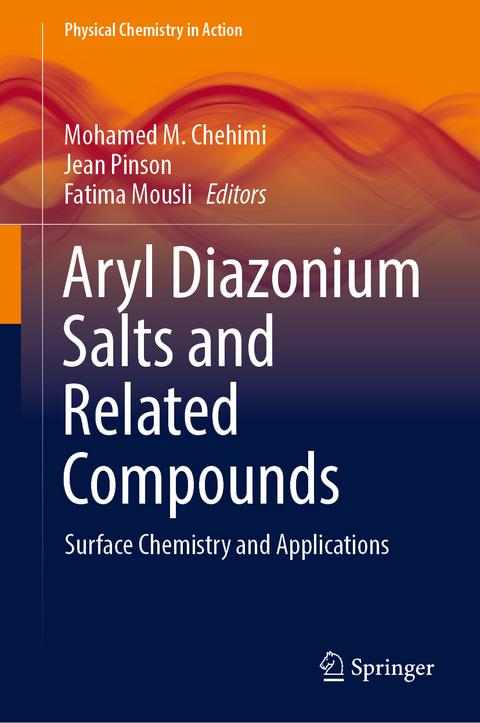
Aryl Diazonium Salts and Related Compounds
Springer International Publishing (Verlag)
978-3-031-04397-0 (ISBN)
lt;p>Mohamed M. Chehimi is Senior Research at French CNRS. He obtained a PhD in physical organic chemistry at the University Paris Diderot in 1988 and joined CNRS in 1989 for a permanent researcher position. His main research topics concern (i) the design of reactive and functional polymer and nanocomposite coatings, and (ii) the valorization of agrowastes into nanoparticle-loaded biochar for environmental applications. He has spent time and efforts developing aryldiazonium salts as new coupling agents in materials science. The applications encompass adsorbents, sensors and actuators, reactive fillers, antibacterial surfaces, electronic devices and supported nanocatalysts. He is an expert on X-ray photoelectron spectroscopy analysis of a broad range of materials including polymer thin films; polymer composites, nanomaterials and materials for sensor devices. Dr Chehimi has supervised over 25 PhD theses and collaborated with academic researchers from 20 countries. He has 350+ research papers, 23 book chapters and 3 patents to his credit. He is the editor of four books and guest-edited six themed issues. He serves as Executive Editor-in-Chief of Chemistry Africa (Springer Nature) and Associate Editor of Surfaces (MDPI).
Jean Pinson is Emeritus Professor at Université de Paris. He graduated in 1963 from Ecole Nationale des Industries Chimiques (Nancy, France). He obtained his PhD in 1969 from Université de Paris and spent one year as a postdoctoral fellow at University of Oklahoma. He became full professor in 1991. From 2004 on, he spent five years as a scientist at Alchimer (now Aveni) a start-up dedicated to microelectronics. His interests include electrochemistry in particular molecular organic chemistry, radical chemistry (SRN1 reactions) and surface chemistry. In 1992 he published the grafting of diazonium salts on surfaces a method now of wide use. He has published more than 190 papers, 9 patents, 12 reviews and book chapters and edited 3 books.
Fatima Mousli has been awarded her PhD in Physico-Chemistry of Materials from the University of Mouloud Mammeri, Tizi-Ouzou, Algeria. This work was conducted within the framework of an international collaboration with ITODYS Lab, Université de Paris (Paris, France). Fatima Mousli has devoted her research to the development of new titania and titania-based heterostructure/conductive polymer nanocomposite and functional hybrid materials based on cotton fabrics for heterogeneous catalysis. One important aspect of her research is focused on the surface/interface chemistry of diazonium salts in view of tightly attaching conductive polymers to metal oxides to surfaces and therefore improving (photo)catalytic performances of titania-based materials. Fatima Mousli has published a series of articles on catalytic nanocomposites and hybrid structures in international peer-reviewed journals and a book chapter on polymer surface modification. She also serves as a peer reviewer for international chemistry journals.
Principle, general features and scope of the reaction, recent advances, future prospects.- Structures, stability, and safety of diazonium salts.- Kinetics and mechanisms of aryldiazonium ions in aqueous solutions.- Iodonium salts as reagents for surface modification: from preparation to reactivity in surface-assisted transformations.- Control of the aryl layer growth.- Grafting of aryl radicals onto surfaces - a DFT study.- Modification of sp² carbon allotropes with diazonium salts - Focus on carbon nanotubes functionalization.- Covalent modification of graphite and graphene using diazonium chemistry.- Aryldiazonium Tetrachloroaurate(III) Salts: Synthesis, Structure, and Fundamental Applications.- Modification and uses of synthetic and biobased polymeric materials.- Surface modification of plasmonic nanomaterials with aryl diazonium salts.- Diazonium electroreduction and molecular electronics.- Modification of surfaces with calix[4]arene diazonium salts.- Diazonium salts and related compounds for biomedical applications.- On the use of diazonium salts in the design of catalytic hybrid materials and coatings.- Aryldiazonium Salts as Photoinitiators for Cationic and Free Radical Polymerizations.- Polymer surface science and adhesion using diazonium chemistry.- Diazonium-modification of plasmonic surfaces formed by laser ablation.- Diazonium salts and the related compounds for the design of biosensors.- Reinforced polymers: the emerging role of diazonium modification of fillers.- Diazonium salts for the preparation of carbon composites with a focus on applications of carbon fibers.- Diazonium salts and related compounds in electrochemical energy storage and conversion.- Recent patents and industrial applications.
| Erscheinungsdatum | 30.06.2022 |
|---|---|
| Reihe/Serie | Physical Chemistry in Action |
| Zusatzinfo | XIV, 482 p. 274 illus., 187 illus. in color. |
| Verlagsort | Cham |
| Sprache | englisch |
| Maße | 155 x 235 mm |
| Gewicht | 904 g |
| Themenwelt | Naturwissenschaften ► Chemie ► Physikalische Chemie |
| Technik ► Maschinenbau | |
| Schlagworte | Diazonium related compounds • diazonium salts • Nanoscience and nanotechnology • surface modification • Thin films and composites |
| ISBN-10 | 3-031-04397-9 / 3031043979 |
| ISBN-13 | 978-3-031-04397-0 / 9783031043970 |
| Zustand | Neuware |
| Haben Sie eine Frage zum Produkt? |
aus dem Bereich


